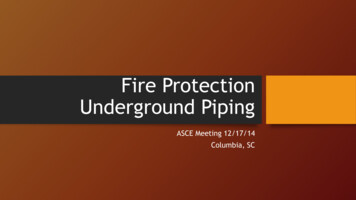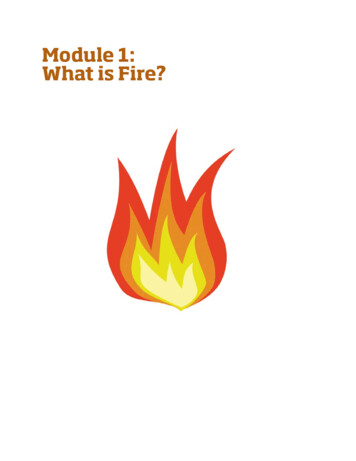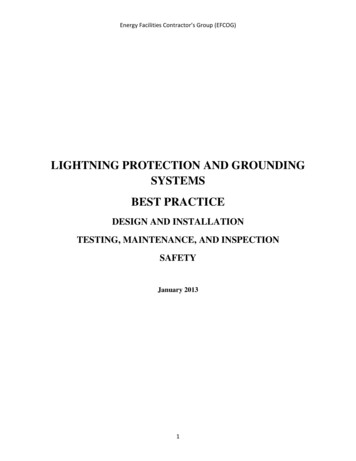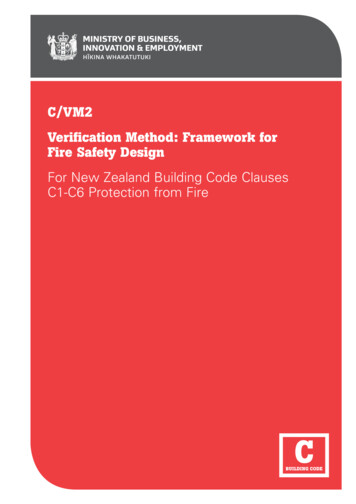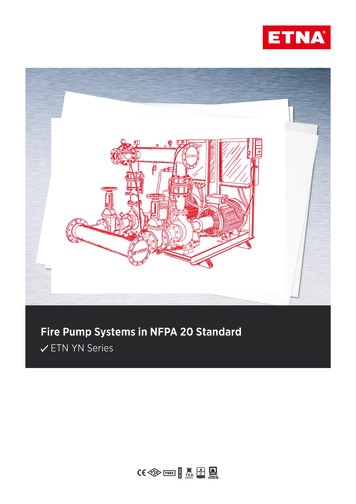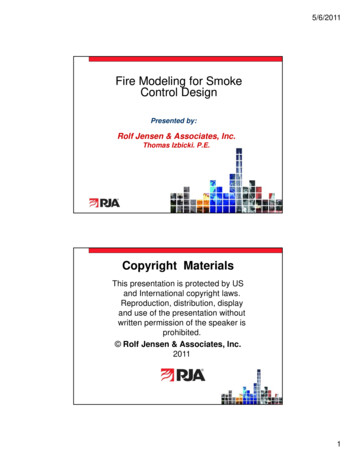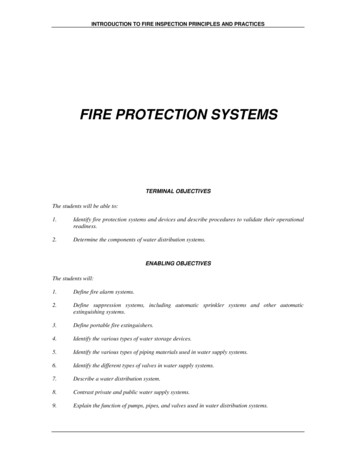
Transcription
INTRODUCTION TO FIRE INSPECTION PRINCIPLES AND PRACTICESFIRE PROTECTION SYSTEMSTERMINAL OBJECTIVESThe students will be able to:1.Identify fire protection systems and devices and describe procedures to validate their operationalreadiness.2.Determine the components of water distribution systems.ENABLING OBJECTIVESThe students will:1.Define fire alarm systems.2.Define suppression systems, including automatic sprinkler systems and other automaticextinguishing systems.3.Define portable fire extinguishers.4.Identify the various types of water storage devices.5.Identify the various types of piping materials used in water supply systems.6.Identify the different types of valves in water supply systems.7.Describe a water distribution system.8.Contrast private and public water supply systems.9.Explain the function of pumps, pipes, and valves used in water distribution systems.
FIRE PROTECTION SYSTEMSSM PS-2
FIRE PROTECTION SYSTEMSINTRODUCTIONUnder the rather broad heading of fire protection systems, this module willexamine the main components of alerting, suppression, and containmentfeatures and systems. Consideration of these systems is a natural adjunctto a discussion of hazards and building construction features.The primary components we will examine are fire alarm systems, firedetection and notification systems, suppression agents and systems, waterdistribution systems, automatic sprinkler systems, standpipe and hosesystems, and portable fire extinguishers. This module will cover a lot ofbasic material meant to provide the novice inspector a solid foundation onwhich to build. As was said in the earlier modules, it is only a beginning.FIRE ALARM SYSTEMSPurpose of Fire Alarm SystemsA properly designed, installed, operated, and maintained fire alarm systemcan reduce the losses associated with an unwanted fire in any building.These losses include property and, more importantly, human life. Theprimary motivation for fire alarm system requirements in building and firecodes is to provide early notification to building occupants so they can exitthe building, and to notify the fire service so it can respond to the fire. Insettings such as hospitals the fire alarm system provides notification tostaff so they can respond to the fire emergency (as opposed to evacuatingthe building). This module will explain the basic features of fire alarmsystems and the inspection of these systems. It should be noted that firealarm systems also are called "protective signaling systems," especially inNFPA documents and in other codes and standards.Basic Components of a Fire Alarm SystemFire alarm systems generally have the following components.Alarm Initiating Device CircuitsThese are the circuits which connect initiating devices such as smokedetectors, heat detectors, manual pull stations, and water flow alarms.Additionally, many system monitor devices important to the overall firesafety of the building also tie in to initiating circuits. These devicesindicate an "abnormal" condition, not a fire or "alarm" condition. TheySM PS-3
FIRE PROTECTION SYSTEMSare referred to as "supervisory devices." One example would be the valvesupervisory switch or tamper switch of a valve controlling the automaticsprinkler system. These types of devices also may be connected tosupervisory type circuits.Alarm Indicating Appliance CircuitsAudible and visible alarm indicating appliances tie in to these circuits toprovide warning to the building occupants. Devices which send a signaloff premises also can be connected to these circuits.Fire Alarm Control PanelThe fire alarm control panel contains the electronics that supervise andmonitor the fire alarm system. The initiating and indicating circuits areconnected directly into this panel.Primary Power SupplyThe primary electrical supply powers the entire fire alarm system.Primary power for fire alarm systems typically is provided by connectinginto the local commercial power service.Secondary Power SupplyA separate power supply that will operate automatically when the primarypower fails and is capable of operating the entire system is considered asecondary power supply.Initiating DevicesInitiating devices fall into one of two main categories: either those thatindicate an alarm condition, or those that indicate an abnormal conditionof a monitored device. A brief description of the common types ofdevices follows.Fire detection can occur by using any device that responds to conditionscaused by fire. The most common byproducts of fire are heat, smoke,flames, and fire gases.In addition, people can detect a fire and initiate an alarm by activating amanual pull station. Also, when a sprinkler system activates and causes analarm, it is a result of the sprinkler system detecting heat produced by thefire (if the sprinklers have fusible links). We will now look briefly at heatSM PS-4
FIRE PROTECTION SYSTEMSdetectors, smoke detectors, flame detectors, gas sensors, manual fire alarmboxes, automatic suppression systems, and indicating appliances.Heat DetectorsHeat detectors commonly are used to detect fires. They are not as prone tofalse alarms and are less expensive than smoke detectors. However, theresponse of heat detectors may not be adequate in many instances, whichlimits their usefulness. Heat detectors are slower to respond to fires thanare smoke detectors because heat detectors cannot respond to smoke. Heatdetectors typically are best suited for detecting fast-growing fires in smallspaces. Heat detectors are also a means of fire detection in locations thatsmoke detectors cannot protect due to such environmental effects as mist,normally occurring smoke, and high humidity. Heat detectors haveseveral different operating mechanisms.Fusible-element type mechanisms use a eutectic alloy that melts rapidlyat a predetermined fixed temperature. When this temperature is reachedand the fusible alloy melts, an electrical contact occurs and causes analarm. Fusible alloys also are commonly used in sprinkler heads. Thesemechanisms must be replaced after each operation.Bimetallic type mechanisms combine two metals with different thermalexpansion coefficients. As the mechanism heats, one metal expands morethan the other, causing a deflection in the shape of the element. Thisdeflection causes an electrical contact, thus initiating an alarm. Thesetypes of mechanisms are self-resetting as the element cools.Rate-compensated heat detectors respond to a given temperature of thesurrounding air regardless of the rate at which the temperature rises. This,in effect, compensates for thermal lag, which standard thermal detectorsdo not do. This can be compared to the rate-of-rise detectors discussedimmediately below.Some heat detectors operate on what is commonly referred to as the "rateof rise" principle. Regardless of the ambient temperature, if the detectorsenses a rise in temperature exceeding a set amount, an alarm occurs. Onemethod of accomplishing this is using a container that has a small venthole. As air is heated it expands; this can cause a set of contactsSM PS-5
FIRE PROTECTION SYSTEMSto close and send an alarm. If the expanding air can leak out of a venthole, the resulting pressure will be reduced. However, if the air expands ata rate faster than the vent hole can compensate for, the contacts will closeand an alarm will be sent.Combination heat detectors can combine the two operating principles ofreaching a fixed temperature and reaching a set rate of rise. Smoke andheat detectors also can be combined into a single unit. It should be notedthat some combination smoke/heat detectors activate when eithercondition is reached, while others require both the smoke and heatmechanisms to operate. In most cases, little benefit, if any, results fromthe combination detector which requires both heat and smoke to cause analarm.Other types of heat detectors include heat-sensitive cables and liquidexpansion detectors.Figure 1Heat DetectorsSM PS-6
FIRE PROTECTION SYSTEMSSmoke DetectorsOne cannot overemphasize the benefits of smoke detectors. However, smokedetectors are not usable in all environments and their effectiveness variesdepending on the fire scenario and occupant capability. The two basicoperating mechanisms currently used in smoke detectors are photoelectricand ionization.Ionization smoke detectors have a small amount of a radioactive materiallocated within the detector that "ionizes" the air entering the detectionchamber. Once ionized, the air particles become conductive, allowing acurrent to flow through the detector circuitry. Smoke entering theionization chamber causes a reduction in the current flowing through thedetector's circuitry. At a certain reduced level of current flow, the detectorsignals an alarm.Figure 2Example of Ionization Smoke Detector with Air Sampling Tubesfor Installation in Duct Work for Air Handling SystemSM PS-7
FIRE PROTECTION SYSTEMSPhotoelectric smoke detectors use one of two methods to detect smoke;however, both use a light-emitting source and a receiver. Photoelectricsmoke detectors that operate on the "light obscuration" principle work asfollows. A light source is directed at a receiver which is accustomed toreceiving a certain intensity of light. When smoke particles enter thedetection chamber they partially block the light traveling from the emitterto the receiver. When the light is reduced or obscured by a certainamount, the detector's built-in circuitry sounds an alarm.The second operating principle used in photoelectric detectors is that of"light scattering." It is more common and operates as follows. Thereceiver in the detection chamber is located so that the light emitted isnormally not "seen" by the receiver. That is, the light emitter and receiverare not aligned as with the light obscuration method. When smoke entersthe detection chamber, light from the emitter strikes it. A fraction of thelight striking the smoke particles is scattered or "reflected" away from thesmoke particle. Some of this scattered light lands on, or strikes, the photoreceiver. When a preset amount of light lands on the receiver, the detectorsignals an alarm.Detectors that operate on the photoelectric principle are generallyappropriate in locations where slow-growing, smoldering fires areexpected. These fires typically generate large size particles (0.3-10microns). They also respond better to light gray smoke as opposed to verydark smoke. Ionization-type detectors respond better to fast-flowing,flaming fires that produce smaller particles (0.01-3.0 microns). Ionizationdetectors respond better to dark smoke than to light smoke. Photoelectricdetectors are better suited than ionization detectors for locations with highhumidity. Air velocity also may affect smoke detector operation.A special type of photoelectric smoke detector is the projected-beamdetector. Here the operating principle is the same as a light-obscurationbased detector but the light emitter and the receiver are physicallyseparated across large areas (e.g., the length of a room). Smoke at anylocation between the two components can result in an alarm. Thesedetectors also can be used in conjunction with mirror systems so that theprojected beam is directed in several directions before ultimately strikingthe receiver.Another special type of smoke detector is the cloud chamber smokedetector. This detection system uses a pump to sampleSM PS-8
FIRE PROTECTION SYSTEMSthe air from a given room. The air is pumped into a high humiditychamber and the pressure in the chamber then is reduced slightly. Ifsmoke particles are present, as the pressure is lowered, moisture willcondense on the smoke particles. This creates a "cloud" within thechamber. The photoelectric principle discussed above is then used todetect the presence of the "cloud" and, hence, smoke.Figure 3Examples of Photoelectric Smoke DetectorsLight Obscuration PrincipleFigure 4Example of Beam Smoke DetectorRecent data indicate that health care facilities, for example, areexperiencing an average of approximately 15 unwanted alarms for everyreal alarm. One problem resulting from these high averages is that peoplemay ignore the fire alarm's warnings during fire drills and actualemergencies, believing it to be "just another false alarm." Quite obviouslythis could lead to a tragedy. Many of the unwanted alarms are attributedto "field" problems such as insects in the detector and other maintenancedeficiencies.Some modifications in detector design are helping to reduce the unwantedalarm problem. Alarm verification recently was approved by U/L. Thisallows the fire alarm panel to "wait" for a specified time period to seewhether the signal from the detector is just from a brief exposure to smokeor from electrical "noise." Device manufacturers are modifying theirSM PS-9
FIRE PROTECTION SYSTEMSproducts continually to reduce the unwanted alarm rate. Systemmaintenance can have a profound effect on the false alarms at facilities.There are other ways to deal with the unwanted alarm situation: propersystem design, installation, and acceptance test procedures. For example,the specification could specify a certain sensitivity rating such as 2.5percent or 3 percent which would eliminate detectors that are too sensitive.During the acceptance test one should verify the sensitivity of thedetectors. Also, proper location of smoke detectors with respect to airdiffusers will assist in reducing unwanted alarms. As a general rule ofthumb, a detector should have a three-foot separation from a supply airdiffuser.Flame DetectorsAnother method of fire detection is detectors that are sensitive to the lightwaves emitted by fires. These typically operate by detecting ultraviolet(UV) or infrared (IR) energy. These detectors are extremely quick tooperate and typically are used only in high hazard areas such as industrialprocess facilities, fuel-loading areas, and areas where explosions mayoccur. Explosion suppression systems protect them. One problem withIR detectors is that they will respond to sunlight, creating an unwantedalarm problem. Besides, both types of flame detectors must "see" theflame to detect it so they usually have to be pointed toward the locationswhere fires are likely to originate.Figure 5Infrared Flame DetectorsSM PS-10
FIRE PROTECTION SYSTEMSFigure 6Ultraviolet Flame DetectorsGas Sensing and Other Phenomena DetectorsGas sensing detectors and "other phenomena" detectors are not common.Special gas detectors sense specific gases given off by a fire; these gasesindicate a fire. For example, there are carbon dioxide and carbonmonoxide detectors. The use of carbon monoxide gas detectors in thehome is becoming very popular as a way of warning residents of gasesproduced by malfunctioning heating equipment.Basically, any method of fire detection not already mentioned is consideredunder the "other phenomena" category. One example is pressure. If a fireburns in a sealed room (the Apollo capsule, for example), excessivepressures develop quickly and can be detected. Some explosion detectiondevices operate this way.Manual Fire Alarm Boxes (Pull Stations)Very common initiating devices, the manual fire alarm boxes usually arereferred to as manual pull stations. These are simple devices whichoperate manually, i.e., they require that a person operate the mechanism.These are found throughout building hallways, near exits, and at otherstrategic locations such as a nurse's station or security center.SM PS-11
FIRE PROTECTION SYSTEMSFigure 7Manual Pull BoxThe manual fire alarm devices provide a means of manually activating thefire alarm system and are used in all types of fire alarm systems. Theymay be the only initiating devices provided, or they may be used withautomatic initiating devices, such as heat or smoke detectors.Manual fire stations generally are located near main exits from a buildingor from a floor of a multistory building and in certain work areascontaining unusual fire hazards, valuable equipment, or records subject tofire damage. Paint shops, aircraft repair areas, computer rooms, andtelephone equipment rooms are examples of such work areas.Automatic Suppression SystemsFire suppression systems can connect into a fire alarm panel so thatactivation of the system causes the panel to signal an alarm. Wet pipeautomatic sprinkler systems commonly have water flow detectors. Aswater starts to flow in the sprinkler piping, it causes a vane to swing intoan alarm position; this sends an alarm to the fire alarm panel. Dry pipesprinkler systems may have pressure sensors for the same reason.All other fire suppression systems also can be connected to the fire alarmpanel. As mentioned above, not all devices signal an alarm condition.SM PS-12
FIRE PROTECTION SYSTEMSMany devices tie into the fire alarm system so that they will alert forabnormal conditions. Perhaps the most common example is that of avalve supervisory switch or "tamper switch" on a sprinkler system. Toassure valves that control a sprinkler system are in the proper position,they can have a tamper switch that will operate if the valve positionchanges. If the valve moves, a signal will appear at the fire alarm panelindicating the valve should be inspected. This is important since someonecould inadvertently, or purposely, close a valve on the sprinkler system,rendering the system inoperable.Many other indicating devices can connect into the fire alarm panel forsupervision. The following is a partial list. water level and temperature in a gravity tank;water level and air pressure in storage tank;status of fire pump;air pressure on dry pipe system; andtemperature in the sprinkler control valve room.Figure 8Examples of Water Flow DetectorsSM PS-13
FIRE PROTECTION SYSTEMSIndicating AppliancesSignal Circuit AppliancesWhen a fire alarm system goes into an alarm condition because of theoperation of an initiating device, several activities can occur. NFPA 101and the building codes may require that a signal be sent to the firedepartment. Activation of the fire alarm panel may cause other events tohappen. In most cases the fire alarm system also provides audible andvisual indications that an alarm condition has occurred. This latterfunction is the most important when considering an occupied building.Figure 9Audible and Visual Alarm Appliances on Indicating CircuitsSM PS-14
FIRE PROTECTION SYSTEMSA fire alarm panel also can perform functions as needed or required.Examples of these would be to control a remote annunciator or to operaterelays that capture and recall elevators. These and other functions will bediscussed further in following sections.Figure 10Local Fire Alarm System DiagramSecondary Power SupplyThe secondary, or backup, power supply is required so that fire alarmoperations can continue if failure of the main power supply occurs. Thesecondary power supply should activate automatically within 30 secondsof the primary power failure to maintain its normal operating voltage.Secondary power supplies should be capable of powering the system atmaximum loading for at least a 24-hour period and then be capable ofoperating all alarm appliances for another 5 minutes. The time periodrequirements for secondary power operation capabilities vary and can befound in NFPA 72, National Fire Alarm Code. Batteries with chargers area common form of secondary power supply and engine-driven generatorsalso are acceptable.SM PS-15
FIRE PROTECTION SYSTEMSTrouble SignalAn important feature of any fire alarm system is the trouble signal. Uponthe detection of an abnormal condition within the fire alarm system, thetrouble alarm signal activates to attract attention to the system so that thecondition can be repaired. NFPA 72 requires as a minimum that allsystems provide an abnormal condition trouble signal for a signal open orground fault of the system's initiating, indicating circuits, and loss ofprimary and secondary power supply to the system.All components of fire alarm systems should be listed for fire alarmsystem use by an acceptable testing agency such as UnderwritersLaboratories (U/L). Additionally, all components must be used only forthe specific function for which they have been designed and tested.Types of Fire Alarm SystemsIn 1993 the National Fire Protection Association incorporated all of theexisting 72 series standards into one standard that also included NFPA 71.This new standard is titled NFPA 72, National Fire Alarm Code.Fire alarm systems can be designed and configured to meet therequirements of local fire codes. In addition to the basic features orcomponents common to most fire alarm systems, there are several "types"of fire alarm systems. These are described here (with a reference to thestandard prior to being incorporated into NFPA 72).Local Protective Signaling SystemThis type of fire alarm is contained entirely within the building which itservices. The main purpose of this type of system is to provide anevacuation alarm for occupants of that building. The system need not beconnected by any means to the fire service. Therefore, notification of thefire service can occur only if someone hearing the evacuation alarm callsand reports the fire alarm. This is the most common type of fire alarm andwas covered previously in NFPA 72A, now part of NFPA 72.SM PS-16
FIRE PROTECTION SYSTEMSAuxiliary Protective Signaling SystemThis type of system is connected to a municipal coded fire alarm boxdedicated to that building. Upon activation of the fire alarm within thebuilding, the municipal box is tripped and sends a signal to the fireservice. It uses the same line as the street fire alarm boxes available to thepublic. This type of system, covered previously in NFPA 72B, is now partof NFPA 72.Remote Station Protective Signaling SystemThis type of system uses leased telephone lines to connect the fire alarmsystem of a given building to a remote receiving station such as the localfire or police station. This type of system, covered previously in NFPA72C, is now part of NFPA 72.Central Station Protective Signaling SystemIn this type of system the fire alarm system is connected to a privatelyowned central station. The central station monitors the fire alarm systemand takes the necessary action when an alarm is received, such as to callthe local fire department to report an activated fire alarm. This type ofsystem, covered previously in NFPA 71, is now part of NFPA 72.Proprietary Protective Signaling SystemThis type of system is similar to the central station system discussedabove, except that the central station is owned by the same concern as thebuilding being monitored. The building(s) being protected may or maynot be on the same property as the central station. Many large facilitiesuse this type of system with the security center serving as the centralstation. This type of system, covered previously in NFPA 72D, is nowpart of NFPA 72.Voice-Alarm Communication SystemSystems can include an emergency voice/alarm communication system.Inclusion of this equipment within the fire alarm system provides for thetransmission of information to occupants of the building. The fireSM PS-17
FIRE PROTECTION SYSTEMSdepartment also can use this equipment while operating within thebuilding. This type of equipment, covered previously in NFPA 72F, isnow part of NFPA 72.Audible and Visual Alarm IndicatorsTo make occupants of a building aware of a possible fire emergency, theymust be notified in some manner. Fire alarm systems typically accomplishthis through audible and visual indicating devices. So that occupants don'tmistake the signals' purpose, and because the building may be occupied byhandicapped persons, there is a need for both types of signals. Forexample, a deaf person will not hear a fire alarm bell and a blind personcannot see a fire alarm strobe light. Bells, chimes, horns, buzzers, andspeakers as well as strobe lights, rotating beacons, and flashing lights arecommon examples of these devices. Many times the audible devices willring in what is referred to as "march time." This means the ringing is notconstant but in an on-off manner. The flashing of lights or strobes actsbetter to alert occupants than a steadily illuminated light. It is commonpractice, but not always desirable, to locate the audible and visual devicesin one unit.In addition to march-time signals, there are "coded signals." Codedsignals, as the name implies, have a pattern (code) that providesinformation regarding the initiation of the alarm. The code may indicate alocation such as a floor or wing where the alarm started. It also could alertthe occupants about the required action. The extent and meaning of anycoded fire alarm signal must suit the needs of a particular facility. Inhospitals, for example, where loudspeaker warnings are common, eithercoded or direct, such warnings and any fire alarm warnings needcoordination so that the two do not interfere with one another. Allsignaling systems should be engineered and tested to ensure they arecapable of alerting all occupants. This requires a knowledge of theanticipated background noises. For example, a mechanical room that hasequipment operating that produces high noise levels may require specialattention.SM PS-18
FIRE PROTECTION SYSTEMSOther Functions Controlled By Fire Alarm SystemsAs mentioned above, fire alarm systems can do more than receive anindication of an emergency and send an alarm. This section will identifysome of the common functions controlled by fire alarm systems. The listis not intended to be all-inclusive.The fire alarm panel can send a signal to the fire department or otherdesired facility via one of the methods described at the beginning of thissection. Elevator capture and recall is a common function that fire alarmpanels can perform easily. Upon receiving an alarm, the fire alarm panelcan operate one or more relays that control the actions of the elevator.The heating, ventilating, and air conditioning system (HVAC) or a smokecontrol system also can be controlled through fire alarm panels.Fire alarm systems frequently include remote annunciators. Briefly, aremote annunciator "displays" the condition of the fire alarm panel at aremote location, usually through lights (LEDs) on graphic or tabulardisplays. Remote annunciators also can have switches that control themain fire alarm panel. The fire alarm panel may be in a secured area out ofthe public way. However, it must be remembered that those investigatingan alarm need to inspect the indicators on a fire alarm or annunciator panelto determine the cause of the alarm and the location of the initiatingdevice. Remote annunciators can be at locations such as the main lobby ofa building, or at a security desk, so that the needed information on thecondition of the fire alarm panel is readily available.Earlier we said that fire suppression systems can tie into fire alarm panelsso that their activation is monitored. Another important function that afire alarm panel can control is the activation of fire suppression systems.In this function, the fire alarm panel identifies a fire through its initiatingcircuits, and activates a fire suppression system such as a halon or CO2system, through a control circuit. This means that fire alarm systems canboth alert when a fire suppression system is activated, and serve as acontrol mechanism when suppression systems are activated. Other typesof fire suppression systems that fire alarm panels can control are preactionand deluge sprinkler systems. We will talk more about these later.SM PS-19
FIRE PROTECTION SYSTEMSFIRE SUPPRESSION AGENTS AND SYSTEMSBasic Fire SuppressionFire suppression and extinguishment involve two essential variables: theextinguishing agent and the system or procedure for applying the agent.The primary methods of achieving fire suppression can be explainedthrough the use of the fire tetrahedron which evolved from the familiar firetriangle. The fire triangle is a graphic representation of the threecomponents that must be present for combustion to occur: 1) fuel, 2) heat,and 3) oxygen. If some of these components are removed or sufficientlyreduced, combustion ceases. Fire suppression involves the removal orreduction of one or more components of the fire triangle. Or so it wasthought until fairly recently.With the advent of halon and a re-evaluation of the dry chemicalextinguishing agents, came a necessity to modify the fire triangle. Inaddition to the removal of one of the three components just described, firecan be put out by interfering with the complex chemical reactions that areconstantly occurring during the combustion process. This "uninhibitedchain reaction" now adds a fourth side to the fire triangle, and the firetriangle becomes the fire tetrahedron.WaterWater is the most common fire extinguishing agent used because it hasseveral features that make it a desirable extinguishing agent. It also hassome limitations. Water can extinguish fire by cooling the fuel below thetemperature at which the fuel can produce flammable vapors. Water alsocan extinguish by smothering, dilution, and emulsification.Water has a very high specific heat; it needs a great deal of heat before itcan change from the liquid to the gaseous phase. Therefore, water appliedto a fire will absorb a large portion of the heat released by the fire. If thereis enough water to absorb the heat, the fire will go out since the fuel coolsbelow the temperature required to liberate additional flammable vapors.Once water is converted to steam, it is still an effective fire extinguishingagent, since the steam can continue to absorb a great deal of heat. It isbest to introduce water into the fire area in the form of a spray as opposedto a stream. A spray will allow for the quicker absorption of heat. For thisreason, sprinklers discharge water in a spray pattern.SM PS-20
FIRE PROTECTION SYSTEMSWhen water transforms into steam, its volume increases approximately1,60
Combination heat detectors can combine the two operating principles of reaching a fixed temperature and reaching a set rate of rise. Smoke and heat detectors also can be combined into a single unit. It should be noted that some combination smoke/heat detectors activate when either condition is reached, while others require both the smoke and heat

